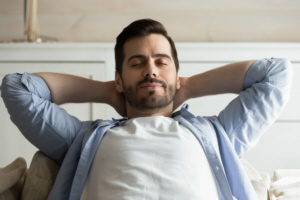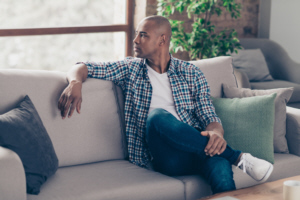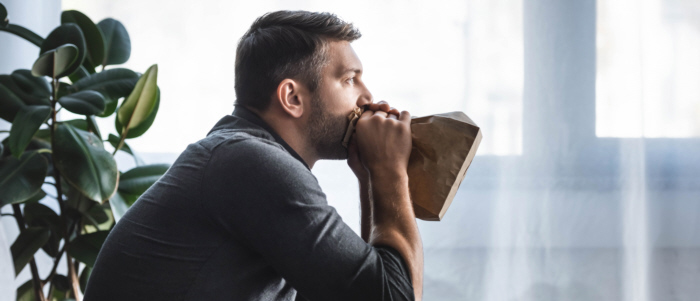Panic Attack or Coronavirus
3 Steps To Distinguish Between A Panic Attack And Coronavirus?
By Athena Staik, Ph.D.
It is natural to feel anxiety and stress during this coronavirus crisis. Elevated levels of stress directly affect breathing, however. Apart from the seriousness of the matter and heart-wrenching reports, watching the news, under the circumstances, may be also be an added threat to your sense of wellbeing and health, mental and physical.
Anxiety disorders, and panic attacks in particular, can mimic coronavirus symptoms, such as shortness of breath. The similarities may also elevate fears for those either previously diagnosed with anxiety, or experiencing elevated states of anxiety for the first time.
If you have worked yourself up and feel stressed about the virus, overthinking what-ifs about the future, it’s likely to take your anxiety to new heights and affect your mental health. Anxious thoughts, however, have the power to unnecessarily activate your body’s survival system.
The fact remains, the human body predictably reacts to anxious thoughts by elevating cortisol levels, and other stress hormones, in the blooding stream. The purpose is to send a “threat alert” to every system of the body, to include your imagination, which may run wild. As all persons that have experienced a panic attack know, the feeling of dying feels real. The logical thinking part of the brain, the frontal cortex, is offline whenever the survival system is activated.
Elevating fears over a prolonged period can have a detrimental impact not only on your emotional and mental health, and the ability to think clearly, it can directly impact the immune system, the health of which is absolutely vital to you at this time, your physical health’s best defense.
This post addresses two questions: One, what’s the difference between a panic attack and acute respiratory syndrome, a condition linked to coronavirus? For your protection and others, the last thing you’d want, in event an anxiety attack occurs, is to rush to the hospital in panic, believing you’ve contracted the virus.
And, question two, when anxiety makes day to day life feel uncomfortable or overwhelming, or you have a first-time panic attack, what are steps you can take to ground yourself in the present, restore your own breathing and sense of relative calm, so you may better handle your response to any stressors, and disallow them from taking over and making you feel they are larger than life? (They’re not! You’re not thoughts or feelings; you’re the miracle-making captain in command. Thanks to neuroscience, we have a manual! Tips and more in Part 2.)
On the distinctions between coronavirus and a panic attack, a key difference from the get go, in psychological terms, is that, while the former poses a possible actual threat (i.e., for those with pre-existing immune disorders or medical illnesses, such as heart, diabetes, cancer, etc.), the latter is not an actual threat to your life, though it absolutely feels like a real threat in the duration of a panic attack.
Now, a few other differences to clarify. Follow the 3 steps below: Pause, Breathe, Think.
 1. PAUSE
1. PAUSE
Your body’s stress response is designed to help you survive. The subconscious mind that directs its operation, however, does no original thinking of its own. It depends on you to critically think, clarify what the problem is, then come up with solutions. Unless you know how to hold fast to the reins, to disallow your subconscious mind from unnecessarily activating your survival system, it can instead quickly take over your imagination, come to misguided and false conclusions, make your heart race and breathing difficult, and possibly lead to desperate actions.
To prevent this from happening, the first step is to pause and become aware of your thoughts. This is where you have leverage, as your thoughts directly activate your emotions and feelings, and from there, these neurotransmitters literally activate what behaviors you take or avoid.
It is a neuroscience fact that, when your body’s autonomic nervous system is in “learning mode” (parasympathetic division), you have the option to thoughtfully respond to a stressor, whereas you do not in “survival or defense mode” (sympathetic division). In fear mode, your body automatically switches off your frontal cortex, remember?
In defense mode, pre-programmed fear-based thoughts, locked in the memory cells of your body, are in control of you, literally. Some of these thoughts may date back to when you were 5 years old. Yet, they still activate the release of cortisol into your body. If you have a tendency to catastrophize (scare yourself with worst case scenarios), for example, and your survival mode takes over, this reactivity can take away your ability to thoughtfully choose, which further elevates your fear.
To prevent this from happening, pause and become aware of what you’re telling yourself. In itself, this intention to think reengages your frontal cortex. With the “thinking or learning mode” re-engaged, you can begin to think again, and critically evaluate the situation, for example, whether or not what you were telling yourself is true, — or helpful to your health and happiness. You may notice your breathing begins to relax.
 2. BREATHE
2. BREATHE
Now, turn your focus to your breathing. According to the World Health Organization (WHO), the 3 primary symptoms of coronavirus symptoms include: fever, dry cough and difficulty breathing. (Other symptoms are aches and pains, nasal congestion, runny nose, sore throat, or diarrhea.)
The first distinction between anxiety and coronavirus, with regard to shortness of breath, is clarified by asking:
Is the shortness of breath over a prolonged period?
In an anxiety attack, shortness of breath tends to last only 20 to 30 minutes, with the peak of difficulty being around 10 minutes. Also certain remedial actions, in the case of panic, can immediately correct the shortness of breath (which is due to hyperventilation), such as initiating deep breathing exercises that oxygenate the body, doing some aerobic exercise, drinking plentiful water, perhaps even eating a light but highly nutritious food, and so on. One or all of these actions together can help to lower anxiety, perhaps end a panic attack on a dime.
In contrast, with COVID-19, there is a prolonged period of shortness of breath alongside flu-like symptoms. The next step is to probe further, engage your thinking.
 3. THINK
3. THINK
Your thoughts create pictures in your mind, and these pictures in turn produce molecules of emotion, so powerful, they literally shape your behaviors. (This also explains it’s smart to avoid TV news altogether if you’re dealing with anxiety!) Emotions move you to stop or take action, not logic! When you unnecessarily scare yourself with the thoughts you think, your breathing automatically becomes short, your heart starts pulsing, your thinking goes into offline mode, and the type of thinking that remains is limited to either-or options, such as fight or flee, sink or swim, etc.
To activate your frontal cortex, as a few probing questions about known symptoms, such as the following set:
- Do you have a fever? If not, it may just be anxiety.
- Are you sneezing, coughing? If not, it may just be anxiety.
- Do you have runny nose or congestion? If not, it may just be anxiety.
When you set an intention to think about what is going on in and around you, you engage no less than your brain’s most powerful capacities, solution-focused and possibility thinking.
You are hardwired to feel safe and secure in your ability to make effective choices that result in realizing and living your best life. This is critical because the same hormone that creates a sense of feeling loving and loved, oxytocin, also creates a sense of feeling safe and secure.
So how important is it, on a scale from 1 o 100, that you learn to self-activate your body’s relaxation response? One hundred!! Just learning a few good deep breathing techniques, taking up meditation and yoga, regular exercise, and so on, supports you to regular your emotions.
Einstein put it this way, “The most important decision we make is whether we believe we live in a friendly or hostile universe.” A favorite president, Franklin D. Roosevelt, emphasized the following in his first inaugural address:
“The only thing we have to fear is fear itself.” ~ FDR
So, do what it takes to never unnecessarily scare yourself; and disallow others from manipulating your fears, as you stay informed. Last but not least, if you or someone you care about, feel overwhelmed in handling anxiety, consider seeing a professional soon; it can really help! And most offer online sessions and teletherapy at this time.

Dr. Athena Staik
3 Steps To Distinguish Between A Panic Attack And Coronavirus is reprinted with permission from Dr. Athena Staik. Thank you Dr. Staik.
Tag: Panic Attack And Coronavirus
Browse Our Selection Of Self Care Articles

